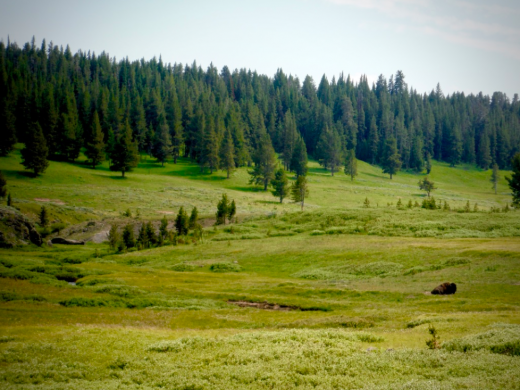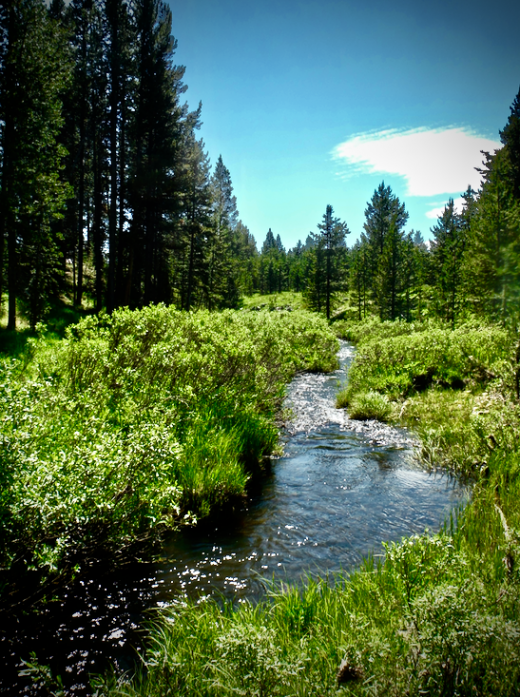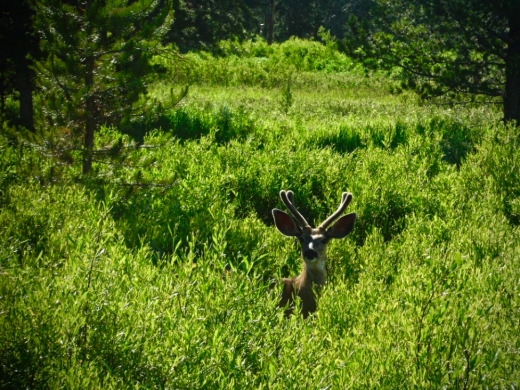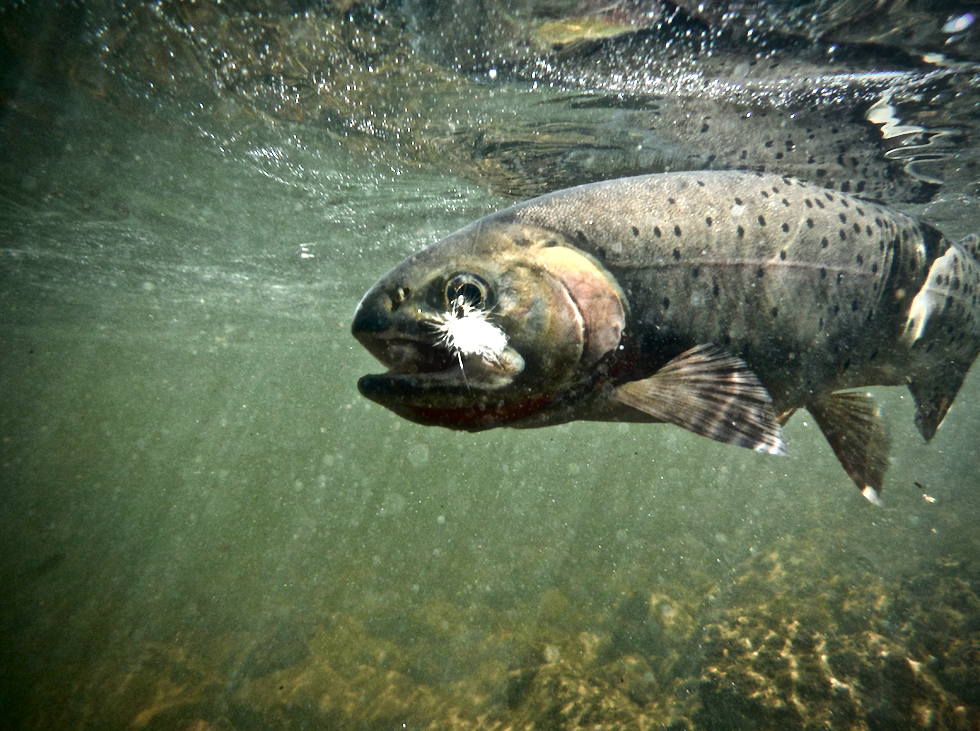A native Yellowstone cutthroat trout. A backcountry treasure. Photo by Chris Hunt.
By Chris Hunt
Who knows how many times I’d driven over the little creek as it flows southeast through an arched culvert toward its eventual confluence with the mighty Yellowstone River. A hundred? At least a hundred. And every time, I made a mental promise.
“I’m going to fish that crick one day.”
I can remember when my daughter and her cousin, Maddie, dressed in identical purple onesies, walked along the pullout just west of the creek—we were part of an old-school Yellowstone moose jam at the time. Both girls were toddlers. Today, they’re all grown up.
And I remember telling my uncle Mark that day that I wanted to fish that creek.
“Go for it,” he said. It’s not like we were going anywhere—a cow and a calf were hamming it up for the tourists, and my visiting family was thrilled at the chance to watch them happily graze among the willows, not a 100 feet from the road. But we had two families of young kids stuffed into a minivan, and we did have a schedule of sorts. Not this time. Another time, maybe.
Years later, not long after the park opened for the season, I remember driving across the little creek for the umpteenth time on our way to see Yellowstone Falls, also for the umpteenth time. Snow shrouded the stream’s modest flow, glistening against the blue April skies. Even still locked in winter’s grip, it looked fishy. But the park’s waters don’t upen to anglers until the Saturday before Memorial Day.
I’ll be back in a month or so, I told myself. That was at least five years ago. Another broken promise.
I get that fishing promises are easily broken, particularly by guys like me who are readily distracted when presented with dozens of choices. And Yellowstone is a destination that brims with choices. More than 4 million people drive through its entrance gates every year, but only a handful stop and get out and walk around. Even fewer take the time to string together a fly rod and fish its hundreds of rivers, streams and lakes. Still fewer wander away from the roadside fisheries into the park’s backcountry to chase wild trout.
I live in a special place, with public lands all around me. Those public lands present literally thousands of fishing options, all year long. But if I want real solitude when I fish, I almost always head to Yellowstone. That may seem counterintuitive, especially if you’ve tried to navigate the main drag in West Yellowstone on a July Friday night—it’s the West’s version of Bangkok, where lane markers are merely suggestions, and throngs of pedestrians impose their will on motorists, sometimes aggressively.

A lonely bison rests in the meadow along a sweet little native trout stream in Yellowstone National Park. Photo by Chris Hunt.
But the beauty of Yellowstone, aside from its roadside wildlife viewing and its geyser basins and azure pools of the clearest water you can imagine, is that the vast majority of the folks visiting never—ever—leave sight of their vehicle. Once you’re on one of the park’s more obscure trails, you really are in wild country.
So, when I pulled into the modest parking lot at the trailhead for this subtle, yet sexy little creek, I knew that once I started walking, I likely wouldn’t see another angler until I fished my way back to the highway. And even then, seeing another person fishing would be unlikely.

A modest little trickle full of immodest—and not so little— native trout. Photo by Chris Hunt.
Fly fishing guidebooks on the park—and there are many (and more to come, I’m sure) — note that this little stream is home to native Yellowstone cutthroat trout. That makes sense, since it’s a tributary to their namesake river. But here’s the kicker—and if you’re really interested, this will almost certainly give you all the directions you need to fish it yourself: the creek hits the river between the upper and lower Yellowstone Falls. That means there’s been no upstream migration of native cutthroat trout from the lower river in eons, and that any genetic refreshment has come from fish migrating out of Yellowstone Lake to spawn in the river and that somehow ended up catapulting over a fairly robust cataract … and surviving the plunge.
That seems like kind of an evolutionary long-shot, to be honest. This is just speculation on my part, so please don’t reference this as anything approaching scientific. But it would seem the native cutthroat trout in this stream have evolved for quite some time without any real meaningful connection to the river.
Pretty cool, huh? Just one of the many “pretty cool” things about Yellowstone.
So, off I wandered along the trail. I hopped off the beaten path about a mile in to give a bison a wide berth, but kept on walking until I figured I’d gone far enough and that fishing downstream to the highway would take me the rest of the afternoon. Then I pointed my 3-weight east and ventured off through the skunk cabbage and lodgepoles in search of the stream.
It was right where I expected it to be, and a single cast of a size 12 Stimulator proved the guidebooks correct. A small and somewhat ambitious cutty hit the fly and quickly came to hand.
I have a colleague in the conservation world who often took note of the work I’d done for Trout Unlimited in the past—it used to be that my summers were spent taking reporters and photographers into wild, backcountry landscapes to show them what was was at risk from the perils that came with unchecked oil and gas drilling, pioneered off-road vehicle trails and the general encroachment of development. Inevitably, we’d end up on some remote, backcountry stream that hold the real gems of America’s wild places: wild and native trout. Usually modest in size, they are big at heart.
“I see you’ve been busy catching small fish,” he said to me once.
“That’s what we do,” I said proudly. “That’s the heritage we’re protecting.”

A mule deer buck in velvet grazes the willows along a native trout stream in Yellowstone National Park. Photo by Chris Hunt.
And this first little cutthroat that came to hand was no different than any other native trout I’ve been lucky enough to pluck from wild water. It was stunning, and full of life.
But being the glutton us backcountry anglers can be, I wanted more. I wanted bigger. So I kept casting and slowly working my way back downstream toward the highway that was still some distance away. And small cutties kept me entertained.
But then I came to some really appealing water. Deep pools shaded by willows. Tailouts that banged into deep, undercut banks. If there were bigger fish here, this is where they’d be. And the casts would have to be spot-on, given the cover and the overhanging brush.
John Denver once sang, “And they say that he got crazy once and he tried to touch the sun.” That’s what chasing native trout in tight quarters is all about—having the nerve to try the impossible … and now and then getting lucky.
Yes, I lost a few flies that afternoon, but I knew I would when I tied them up months earlier. This is what I tied them for. These were the fish I had in mind. I tried to touch the sun.
And when I brought that first 15-inch beauty to hand after a dozen or so failed attempts, I knew that fortune had, indeed, smiled upon me. When the second fat cutthroat rose to the fly inches away from where I caught the first one, I knew it was just one of those days … those epic days where creek freaks like me get lost in the ether and forget everything else that matters.
I love those days.
I made it back to the highway at dusk. I finally kept that promise.
Chris Hunt is the national digital director for Trout Media. He lives and works in Idaho Falls.



